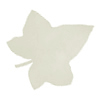


|
A hardy perennial herb, which when brushed against or crushed releases a delicious lemon fragrance. Similar in appearance to the nettle (without the stinging hairs) or mint (to which it is related), with tiny white flowers. Balm has a long association with bees - the botanical name Melissa being derived from the Greek for honey bee, and according to bee folklore if the beehive is rubbed with Balm the bees will not swarm and the fragrance will attract new bees. Apparently Balm was also a sacred herb used in the temple of Diana. John Evelyn (1620 - 1706) stated the "Balm is sovereign for the brain, strengthening the memory and powerfully chasing away melancholy," the German herbalist Paracelsus ascribed Balm as an "elixir of youth," and the Greeks considered it a cure all. Balm,
or Lemon Balm as it is perhaps more commonly called
nowadays, has a long tradition as a tonic remedy
and one which raises the spirits and comforts the
heart. It is a nerve tonic and relaxant with antispasmodic
and carminative actions, and makes an excellent
remedy for mild depression, panic attacks, palpitations,
irritability, restlessness and anxiety - especially
if the anxiety is causing indigestion. Balm is also
useful as a remedy for nausea, bloating, acidiy,
stomach spasms, colicky pains, flu with muscle aches
and pains, and can help reduce fever temperatures.
It is also a gentle herb which is good for soothing
nervous tummy upsets in children. Lemon Balm is also an antiviral herb and research has shown it to be extremely effective against several bacteria and also the herpes simplex virus (the one responsible for cold sores) and other viral infections, including mumps, shingles and chicken pox. Not only will it help relieve cold sores but it may also reduce the chances of further outbreaks, when drunk regularly. An infusion of the leaves would make a soothing wash for irritated skin - the juice of Balm can also be applied to cuts and grazes as it contains eugenol, making it anti-bacterial as well as capable of numbing the surrounding tissues. As an antioxidant herb it makes a good choice for a regular herbal tea - the antioxidants mop up free radicals - I like to blend it with Nettle, but it blends well with most herbs. If you want to make a blend for insomnia try Lemon Balm mixed with Catnip, Chamomile or Valerian Root. A soothing blend, particularly for stomach upsets and nerves / anxiety is Lemon Balm and Chamomile. The antioxidants would also make Lemon Balm a useful blend for preventing catarracts - try blending it with Catnip and Mint. Many herbalists suggest that Lemon Balm is beneficial for Alzheimer's disease, attention deficit/hyperactivity disorder (ADHD), and both hyperthyroidism and hypothyroidism (suggesting that Lemon Balm has a regulating effect on the thyroid). Lemon Balm has had many uses over the centuries (in addition to being a medicinal herb) - it was the principal ingredient of Carmelite water used during Mediaeval times by men and women after bathing, and the fresh leaves can be eaten raw in saldas or dried and used in herbal bath blends, toilet waters, pot pourri, as a strewing herb, or in hot or cold drink. It can also be used to flavour soups, stews, sauces and dressings.
Bunches of Lemon Balm hung up to dry after harvesting. The
optimum harvest time is generally just before the
flowers appear, or just after they have opened as
a second best, but this plant is such a prolific
grower that small harvests can be made regularly
throughout the summer. Ensure you leave some un-harvested
for the bees. Every garden should have some Lemon Balm - even if just to delight the bees - it's an easy herb to grow and once established will happily spread, and the experience of brushing your hands through a clump of Balm will bring a smile of sunshine to the gloomiest of faces as the zesty fragrance wafts through the air. Try rubbing a leaf gently on your pulse points for a simple, comforting natural perfume. |
|

Gaia's Garden Library
Non Fiction Section : Gaia's Garden Herblore | Susun S. Weed Articles | Articles and Musings
Fiction Section : Short Stories & Prose| As Told
By Cat | Public Domain Texts| Poetry
Shop | Library | Gallery | Forum | Contact | Links









